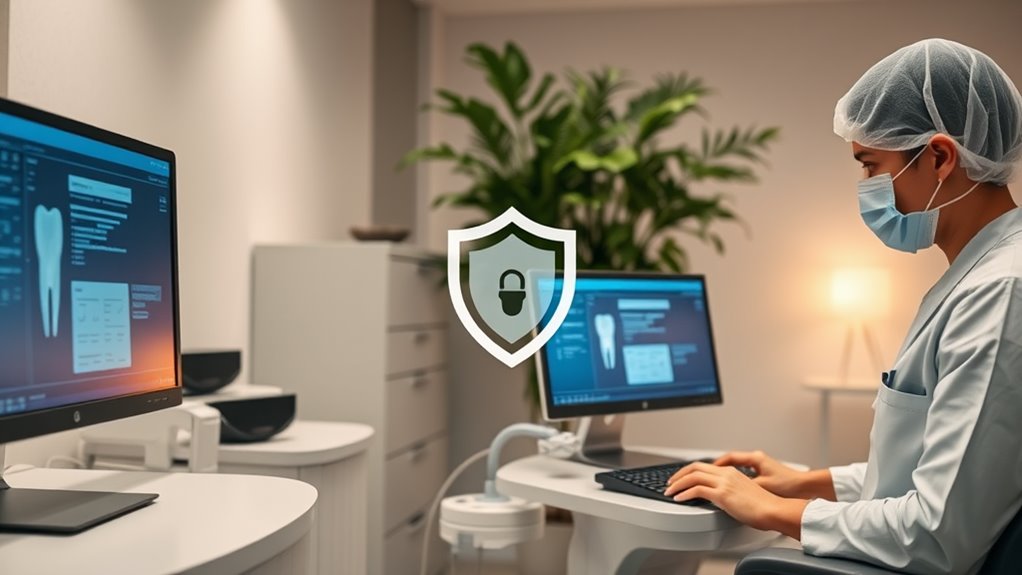3 Best Strategies to Shield Patient Data in Dentistry
If you think patient data security in dentistry is as simple as locking a door, you're in for a wake-up call. In a world where cyber threats loom large, it's crucial to adopt effective strategies to safeguard sensitive information. You need to take into account robust security measures, compliance with HIPAA regulations, and reliable IT solutions. But how do these strategies work together to create an impenetrable shield? Let's explore the critical steps you can take to guarantee your practice is protected.
If you're looking for assistance in implementing these strategies or have questions about patient data security, feel free to reach out to us. We can connect you with experts who can provide tailored solutions to enhance your practice's security.
Implement Strong Security Measures
To effectively shield patient data in dentistry, implementing strong security measures is vital. Begin by encrypting patient data both in transit and at rest. This guarantees that sensitive information remains unreadable without the appropriate encryption key. Additionally, secure network infrastructure is important. Use firewalls and intrusion detection systems to protect your network, and conduct regular security audits to identify vulnerabilities.
Employee training plays a pivotal role in your security strategy. Regular training programs will equip your staff with the necessary knowledge to recognize and respond to potential threats. It is also essential to ensure that all team members are familiar with the workplace information security policy to enhance their understanding of data protection responsibilities.
Establish a well-defined incident response plan that outlines communication protocols, containment measures, and data recovery procedures. This plan should also include policies for reporting and mitigating data breaches. Furthermore, confirm that all software is kept up to date and that practice management tools meet industry standards for security.
Utilize secure storage solutions, both physical and electronic, to prevent unauthorized access. By integrating these strong security measures, you not only protect patient data but also foster trust within your practice and the community you serve.
Ensure Compliance With HIPAA Regulations
Guaranteeing compliance with HIPAA regulations is crucial for dental practices aiming to protect patient data effectively. You must understand the HIPAA Privacy and Security Rules, which safeguard individually identifiable health information and electronic protected health information (ePHI).
Familiarize yourself with the specific requirements for dental practices, including adherence to stronger state regulations if applicable. Additionally, HIPAA compliance is a legal requirement that safeguards patient privacy and confidentiality, reinforcing the importance of following these regulations.
Conducting regular risk assessments is critical. You should analyze how patient data is collected, stored, accessed, and shared, identifying vulnerabilities in your current policies and procedures. This ongoing evaluation helps determine the best strategies for protecting patient data against potential threats.
Additionally, prioritize staff training to make certain your team is well-versed in HIPAA regulations and best practices. Conduct annual training sessions that include updates on new regulations and develop clear privacy policies outlining the handling of protected health information (PHI).
It's important to enforce these policies and implement sanctions for non-compliance.
Use Secure IT Solutions
Effective patient data protection goes beyond regulatory compliance; it also requires robust IT solutions. To shield sensitive information, start by implementing powerful firewalls and intrusion detection systems. These tools block unauthorized access and monitor potential threats, guaranteeing your network remains secure.
Regular security audits will help identify vulnerabilities, and organizing computer systems can prevent the spread of security issues. Additionally, data breaches in dental practices have risen significantly, highlighting the urgent need for these protective measures.
Utilizing advanced data encryption is essential. Encrypt patient data both in transit and at rest, making it unreadable without the encryption key. This includes implementing secure messaging systems and using encrypted databases within your practice management software.
You should also confirm all electronic patient forms and digital media are securely stored.
Maintaining updated and patched systems is non-negotiable. Establish a routine for updating software and verify critical applications receive timely patches. This proactive approach minimizes vulnerabilities.
Lastly, adopt a thorough data backup and recovery strategy, like the 3-2-1 method. This involves having three copies of data, two onsite and one offsite.
Frequently Asked Questions
What Should I Do if a Data Breach Occurs?
If a data breach occurs, initiate your breach response plan immediately. Document the incident, assess the impact, and follow notification procedures to inform affected individuals and authorities, ensuring compliance with legal requirements and protecting patient trust.
How Can Patients Ensure Their Data Is Secure?
Imagine your data as a treasure chest. To keep it safe, use data encryption and secure passwords. These tools guard against unauthorized access, ensuring your sensitive information remains protected, just like the treasures inside.
What Are the Consequences of HIPAA Violations?
If you violate HIPAA, you'll face legal ramifications, including lawsuits and corrective action plans. Financial penalties can range from $100 to $50,000 per violation, severely impacting your practice's viability and reputation.
How Often Should We Conduct Risk Assessments?
You should conduct risk assessments annually, following frequency guidelines. Utilize effective assessment techniques to identify vulnerabilities. In high-risk environments or after significant changes, consider more frequent evaluations to guarantee ongoing compliance and patient data protection.
What Types of Training Should Staff Receive on Data Security?
Your staff should receive training on security protocols and cybersecurity awareness, emphasizing data protection techniques, recognizing threats, and implementing best practices. Regular updates guarantee they remain vigilant and capable of safeguarding sensitive information effectively.
Conclusion
In today's digital landscape, safeguarding patient data in dentistry isn't just necessary; it's like locking the door to your practice. You wouldn't leave it wide open, would you? By implementing strong security measures, ensuring HIPAA compliance, and utilizing secure IT solutions, you create a fortress around sensitive information. Remember, a single breach can compromise trust and lead to significant consequences.
If you're feeling overwhelmed by the complexities of data protection, don't hesitate to reach out to us for assistance. Our expertise can save you time and reduce stress, allowing you to focus on what you do best—caring for your patients. By prioritizing these strategies with our help, you can enhance the security of your practice and maintain the integrity of your operations. Secure data leads to secure smiles, and we're here to ensure that your practice thrives in a safe environment.





